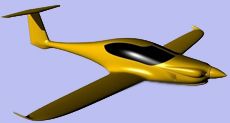
The first aircraft from Pipistrel’s coming Panthera line will carry four people and full fuel for more than 1000 nautical miles, with reserves, at 202 KTAS, while burning 10 gallons per hour — and it may be the least efficient of the Panthera line. Pipistrel has plans to produce three versions of the aircraft, including the previously described unleaded-ready Lycoming IO-390-powered model; a Panthera Hybrid that includes a 145 kW hybrid-electric powertrain (offering quiet, pure-electric takeoff and landing); and a Panthera Electro, flying with a 145 kW pure-electric system that targets a range of 215 nautical miles. Where the pure-electric version offers apparent compromises, Pipistrel’s description of the Panthera Hybrid offers nothing of the kind.
According to Pipistrel, the Panthera‘s “short-field, powerful climb, extreme aeroefficiency and long range” will be “further enhanced with the revolutionary hybrid powertrain.” In fact, Pipistrel says its Hybrid is “a quantum leap forward” that will “pave the way for the future of aviation.” The Lycoming-powered version requires a 1200-foot ground roll for takeoff that grows to 2200 feet when climbing over a 50-foot obstacle. Landing over that obstacle requires 1900 feet. Specifications defining the full capabilities of the hybrid are still forthcoming. Inside the aircraft, Pipistrel describes the rear seating as two-plus-one and, as a four-seater, “comfortable for passengers of any body type.” Panthera’s avionics gather around a Garmin G500 PFD/MFD and include touch-screen finger-drawn flight planning capability. The aircraft feature the GTN 750 and 635 dual COM/NAV. “Draw a path on the navigation screen with your finger and Panthera’s full-featured autopilot can follow it,” says Pipistrel. All Panthera airframes are based on carbon fiber composites, with strategic placement of antistatic materials and Kevlar, set on trailing link titanium retractable gear. All actuation systems are electric, to keep weight and complexity down, and there is a full-plane parachute designed to function at low and high speeds, and also at low altitudes. The aircraft will fly behind a custom-designed propeller and will use optimized exhaust systems. We expect to see the roughly $395,000 piston-only powered version, soon, with the hybrid and full-electric version to follow by roughly 2013.


































